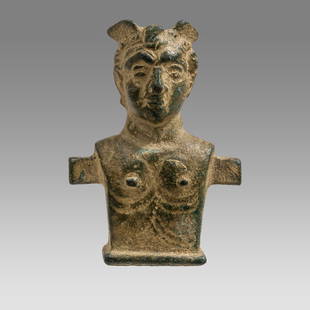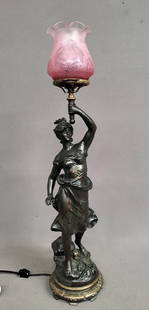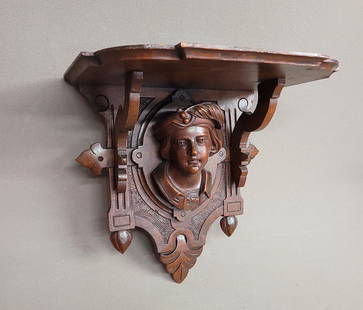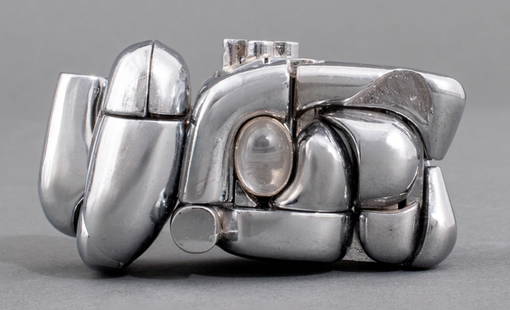
Bust of a Roman barbarian. Ancient Rome, circa 300 AD. Marble. Damaged, nose restored.
Similar Sale History
View More Items in Busts
Related Busts
More Items in Gothic Busts
View MoreRecommended Sculptures & Carvings
View More






Item Details
Description
Bust of a Roman barbarian. Ancient Rome, circa 300 AD.
Marble.
Damaged, nose restored. There is a crack in the tunic and a hole in the back and support.
Provenance: Ex collection C. Mercier, 1960 / Baidun Gallery, Israel, 2015; Exhibited: Ifergan Collection, Malaga (2018-2020).
The bust is still on its original pedestal.
The lower part is a later addition from the 17th and 18th centuries.
Measurements: 50 cm.
This bust is a faithful representation of one of the many non-Roman citizens who made up the population of the region. It is a male figure who only covers one of his shoulders with his tunic, baring the rest of his chest to the viewer. Although he is vulnerable as a non-citizen, he has the inherent strength of a man outside the law of the Empire, evident in his muscular torso and scowl.
The Romans brought two important innovations to the world of sculpture: portraiture and historical relief, neither of which existed in the Greek world. However, they followed Greek models for much of their sculptural production, a basis which in Rome was combined with the Etruscan tradition. After the first contacts with Classical Greece via the Magna Graecia colonies, the Romans conquered Syracuse in 212 BC, a rich and important Greek colony in Sicily, which was adorned with a large number of Hellenistic works. The city was sacked and its art treasures taken to Rome, where the new style of these works soon replaced the Etruscan-Roman tradition that had prevailed until then. Cato himself denounced the looting and decoration of Rome with Hellenistic works, which he considered a dangerous influence on native culture, and deplored the Romans' applause of statues from Corinth and Athens, while ridiculing the decorative terracotta tradition of ancient Roman temples. However, these oppositional reactions were in vain; Greek art had subdued Etruscan-Roman art in general, to the extent that Greek statues were among the most coveted prizes of war, being displayed during the triumphal procession of the conquering generals. Shortly afterwards, in 133 BC, the Empire.
Marble.
Damaged, nose restored. There is a crack in the tunic and a hole in the back and support.
Provenance: Ex collection C. Mercier, 1960 / Baidun Gallery, Israel, 2015; Exhibited: Ifergan Collection, Malaga (2018-2020).
The bust is still on its original pedestal.
The lower part is a later addition from the 17th and 18th centuries.
Measurements: 50 cm.
This bust is a faithful representation of one of the many non-Roman citizens who made up the population of the region. It is a male figure who only covers one of his shoulders with his tunic, baring the rest of his chest to the viewer. Although he is vulnerable as a non-citizen, he has the inherent strength of a man outside the law of the Empire, evident in his muscular torso and scowl.
The Romans brought two important innovations to the world of sculpture: portraiture and historical relief, neither of which existed in the Greek world. However, they followed Greek models for much of their sculptural production, a basis which in Rome was combined with the Etruscan tradition. After the first contacts with Classical Greece via the Magna Graecia colonies, the Romans conquered Syracuse in 212 BC, a rich and important Greek colony in Sicily, which was adorned with a large number of Hellenistic works. The city was sacked and its art treasures taken to Rome, where the new style of these works soon replaced the Etruscan-Roman tradition that had prevailed until then. Cato himself denounced the looting and decoration of Rome with Hellenistic works, which he considered a dangerous influence on native culture, and deplored the Romans' applause of statues from Corinth and Athens, while ridiculing the decorative terracotta tradition of ancient Roman temples. However, these oppositional reactions were in vain; Greek art had subdued Etruscan-Roman art in general, to the extent that Greek statues were among the most coveted prizes of war, being displayed during the triumphal procession of the conquering generals. Shortly afterwards, in 133 BC, the Empire.
Buyer's Premium
- 23%
Bust of a Roman barbarian. Ancient Rome, circa 300 AD. Marble. Damaged, nose restored.
Estimate €80,000 - €90,000
7 bidders are watching this item.
Shipping & Pickup Options
Item located in Barcelona, -, esSee Policy for Shipping
Payment

TOP




































































